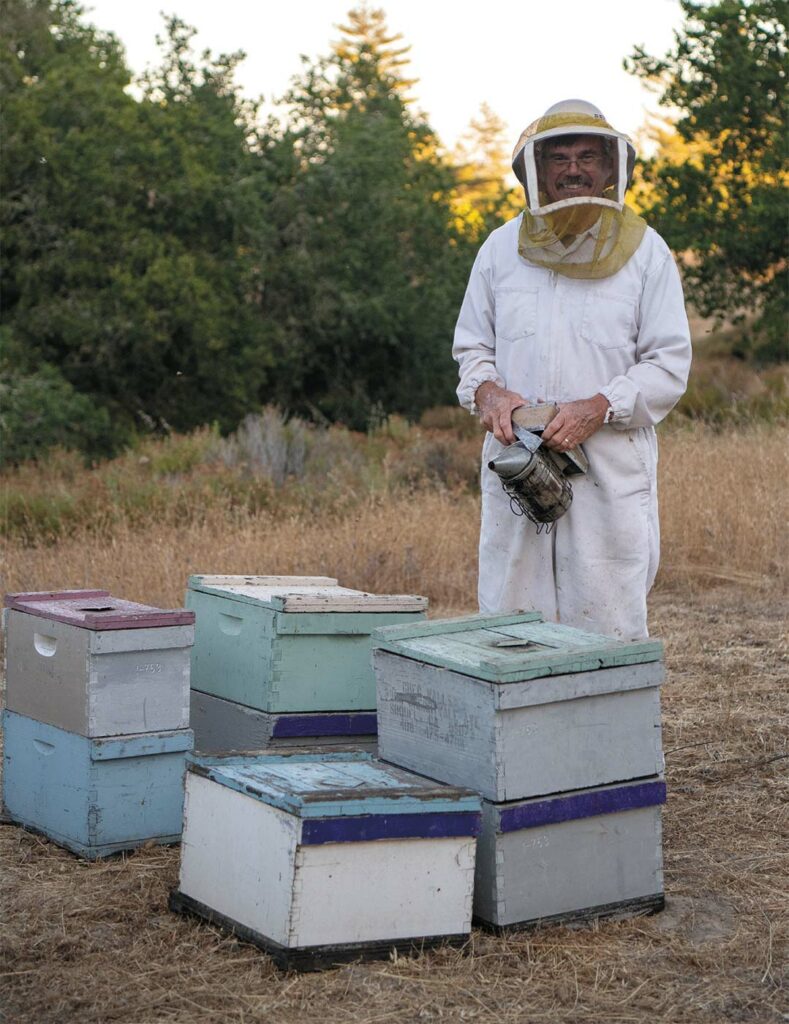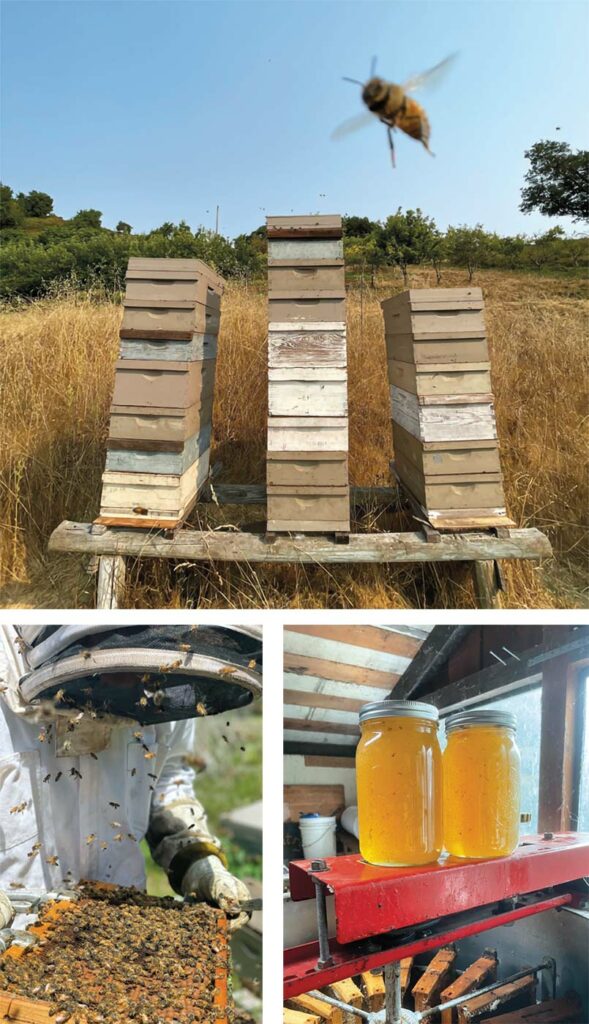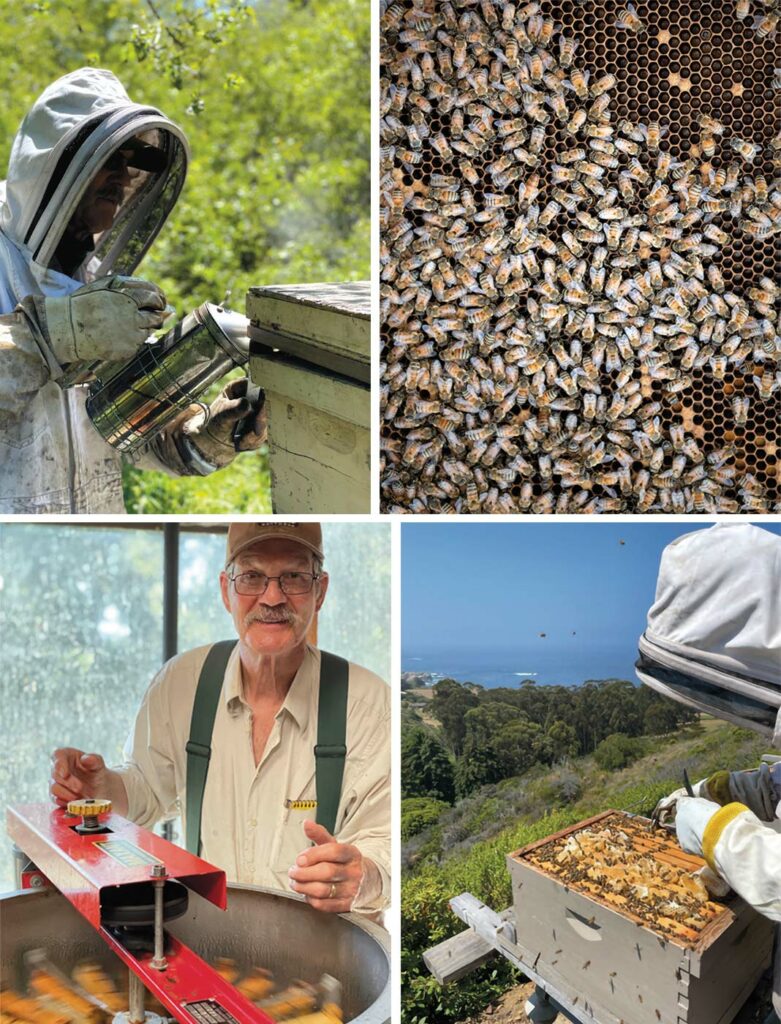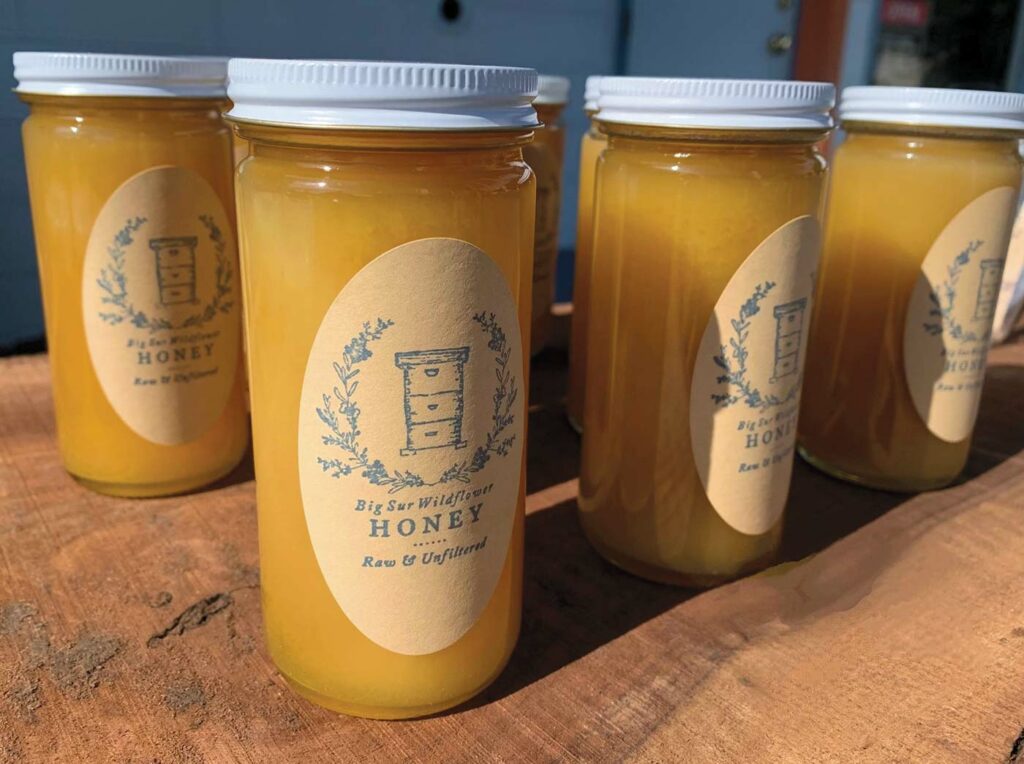
The prolonged drought was devastating to local bee populations, but what about the cold, wet winter of 2022-23? Local beekeepers have the lowdown on this year’s harvest.
PHOTOGRAPHY BY COLINE LECONTE
Inside Jeff Walls’ honey house in Soquel are two dirt bikes. “When Jeff was a kid, he really wanted one, so his dad told him to earn the money by working with the bees. That’s all he’s wanted to do ever since,” says Walls’ wife April.
She hands me a frame from one of their hives and invites me to poke into it to release the pale blonde liquid inside. This particular varietal is sage, the most ethereal and delicate of honeys, akin to what a riesling might be to wine lovers. April then explains the process of extraction, which frankly sounds like way too much work, but given what honeybees must do to create and store honey, it seems a worthy effort.
The recent 10-year drought has been tough on farmers and crops, but dire for bees. Fewer flowers and shorter growing seasons resulted in smaller crop sizes and yields, leaving them weak and thus more susceptible to disease.
Conversely, torrential rains last winter caused massive flooding not just on the Central Coast, but also in the Central Valley where crops like almonds, cantaloupes, cashews, pistachios, cherries, plums and peaches are grown. Hundreds of hives were lost throughout the state. More rain, followed by cold, damp weather, delayed the spring bloom.
“The drought years were hard,” says April, whose father-in-law Greg started the family honey business three decades ago. “The flowers had no nectar and our production was way down. We had to leave a lot of the honey in the hives for our bees to live on.” Each hive houses approximately 60,000 bees, including one queen.

Most of the Walls’ 200-plus hives are kept at Everett Family Farm, also in Soquel, but some are transported to pollinate fruit trees, broccoli and winter squash. Have you ever tasted lima bean honey? It’s redolent of a dark amber maple syrup, with a hint of baking spice. “This year we got a really late start due to the weird weather, but at least we had crops that needed bees,” says April. She’s hopeful for a good yield this year.
Meanwhile in Big Sur, Peter Eichorn of Country Flat Farm in Palo Colorado Canyon has been keeping bees since 1964. He’s mostly retired now with just nine hives, having lost 26 to the drought and mites.
Eichorn’s hives are located at Glen Deven Ranch, which is part of the Big Sur Land Trust. Hives have been kept there since the 1920s, and it’s also the location where author Meredith May’s grandfather, E. Franklin Peace, kept bees in an old Army bus as described in her memoir, The Honey Bus. The book details her 1970s childhood in Carmel Valley following her parents’ divorce.
“I took over the hives from Franklin when he retired,” says Eichorn. “It’s mostly eucalyptus and sage in this area. Sage honey is very dense and slow to crystallize. Bees can get more nectar from it than any other flower species in California.”
Eichorn says the 2023 season got off to a very slow start due to the unseasonably cold weather. “Bees must survive on their stores until mid-April around here. I have a location in mid-Carmel Valley that’s warmer through the winter and has a greater variety of floral sources, but here in the canyon, the eucalyptus trees are way down low by the creek where it’s not warm enough for the bees to fly.”
Last year, Eichorn only harvested 1,100 pounds of honey due to the drought. “Honey is way heavier than water,” he says. He’s hoping to get two harvests this season, but he has a new challenge beyond the weather: a juvenile black bear has discovered how wonderful the honey is, and has yet to get a pot stuck on his head.
Have you ever tasted lima bean honey? It’s redolent of a dark amber maple syrup, with a hint of baking spice.

Farther south, Big Sur Honey is the passion project of Dylan Horst and Jessie McKnight, who live off the grid in Lucia with their two children. They keep 100 hives in their backyard, an endeavor that began 12 years ago, after Horst watched an apiarist capture a wild swarm. From that moment, he began searching for his first swarm. All his bees are wild, native species, never purchased.
He’s carefully selected queens for vigor and his hives have successfully grown stronger. Although other beekeepers treat their hives to mitigate disease, he has never needed to do so.
“I absolutely fell in love with bees,” he says, although his day job is managing a landowner’s property on the Big Sur coast. To make beekeeping his primary vocation, he’d require at least 200 to 300 hives, a daunting task for just one person.
“This is very wild land,” says Horst. “We are lucky in a way and unlucky in another. The native tree and shrub season here is short, and if we were in an area with more human influence, there would actually be more opportunities for bees.” Humans plant lots of flowers, shrubs and other species as well as food crops, which further extend the nectar season. “Still, here I don’t have to worry about pesticide residues from agriculture,” he adds.

While Big Sur Honey mainly sells its honey in jars, Horst says the best way to enjoy it is from a comb. “I love comb honey, but most people do not understand it,” he says. “My grandfather loves it, and that’s all he will eat. This is la crème de la crème: it melts in your mouth. It is absolutely the highest quality honey of all. Please ask for it!”
This year, Horst had all of his honey collected by mid-July. His harvest last year totaled 2,000 pounds and he was hoping his yield for 2023 would be double that.
His employer gives him two to three months off to harvest and get the hives ready for winter, when the bees hibernate. “For those of us who keep hives in rural, non-agricultural regions, fall is the beginning of winter. It’s the brown season already; there’s nothing left flowering here.” Horst’s bees will live off of their honey store, then go dormant until next spring.
And as we head into the fall season, now is the time to stock up on all these wonderful honeys to help sweeten up what will hopefully be another wet winter.
Honey is truly one of nature’s most precious gifts, and we thank beekeepers for the essential work they do in preserving this essential element in the food chain. Bees are to agriculture what canaries are to coal mines.

Where to buy Jeff Walls’ Family Honey:
Walls’ honey house in Soquel, local markets and Clementine & Co. in Capitola. Contact April Walls by text at 831.588.5016
Country Flat Farm: Earthbound Farm’s Farm Stand, the Phoenix Shop at Nepenthe, Carmel Highlands General Store and countryflatfarm.com.
Big Sur Honey Company: Coast Big Sur Gallery and bigsurhoneycompany.com.
About the author
Laura Ness is a longtime wine journalist, columnist and judge who contributes regularly to Edible Monterey Bay, Spirited, WineOh.Tv, Los Gatos Magazine and Wine Industry Network, and a variety of consumer publications. Her passion is telling stories about the intriguing characters who inhabit the fascinating world of wine and food.
- Laura Nesshttps://www.ediblemontereybay.com/author/lness/
- Laura Nesshttps://www.ediblemontereybay.com/author/lness/
- Laura Nesshttps://www.ediblemontereybay.com/author/lness/
- Laura Nesshttps://www.ediblemontereybay.com/author/lness/


